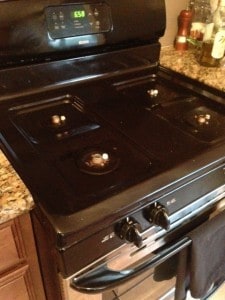 A few weeks ago I did something stupid… something that haunted my mind, home, and world for four days.
A few weeks ago I did something stupid… something that haunted my mind, home, and world for four days.
I accidentally spilled about four cups of vegetable oil on and in my gas stove.
How this happened is a story of safety, but also one of hope! After I thought I had a dead stove on my hands, I buckled down, did some research, conquered my fear of explosions, and fixed that sucker.
I thought I would share this situation with you all mainly because I thought it ended up to be kind of funny, but also because it’s a story of something that went horribly wrong in my kitchen. Hopefully by sharing it, I can save you the trouble!
I did take a few pictures as I fixed this disaster, but honestly, I didn’t photograph every step over the three days it took me to fix the problem because I was just too focused on cursing.
Rivers of Oil
Let me set the scene for you: I’m making French fries. I’ve done it a thousand times on my stovetop. I get my large frying pot out and fill up the pot with the normal amount of oil. I use my deep fry thermometer to make sure the oil is the right temperature.
But, I was in a hurry which is frequently the problem when stuff goes wrong. So I cut my fries into shoestrings and tossed them in without drying them off or starting slowly. Just a big handful of wet fries in a big pot of oil.
Luckily, I cook enough that literally as soon as I did this I realized that I had just made a huge mistake so I turned off all the burners on the stove. If I hadn’t done that when the volcano of oil erupted out of the pot it would’ve started The Great Grease Fire of 2013. Since I turned off the burners though it just overflowed.
And overflowed. And overflowed.
I’m not sure how much oil came out of the pot, but I would guess at least four cups.
A Short Term Fix
As any person (but especially a man) might do, I was pretty sure I could short term fix this situation. I waited until everything cooled down and then I took off all the burners and soaked up as much oil as I could see. I washed it well and figured it was good to go.
I then proceeded to make dinner.
The thing about oil is that it’s a liquid and a slippery one at that and while I was sitting there waiting for the oil to cool, it found its way into every little crack and crease of my stove, dripping down and into the body of the stove. I found this out very quickly because when I tried to cook a meal, I created a noxious gas.
I wouldn’t call it smoke because it wasn’t dark really. It didn’t smell like smoke and actually didn’t smell like burning oil (I’m familiar with smell). It smelled chemically which I figured wasn’t a good thing.
Betsy and I, along with the friends we were feeding and Porter, had to clear out! It was maybe the worse smell I’ve ever smelled.
Calling the Experts
The next day I woke up with a clear head and tried to figure out how to tackle the problem. I called my property management company first and they said just to run the “self clean” feature. I did this and almost killed my pets. The smoke that came out was so strong and gross and putrid. It was like ammonia plus baby diaper with a sprinkle of smelling salts.
I decided to STOP the self-cleaning. In hindsight, this was the smartest thing I did because if I would’ve kept running it I would’ve burned our house down.
I let the oven cool down and decided to open it up and see what I could see. This is what I found:
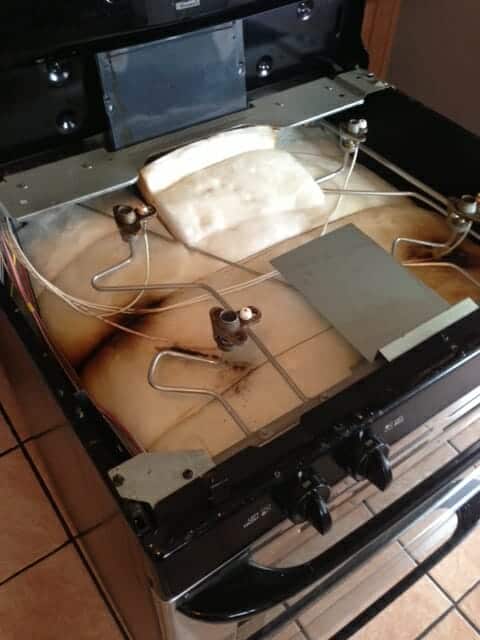
You see those huge black areas? Yep. That’s the insulation which is supposed to be fireproof that has melted releasing who knows what kind of toxic crap into the air. Hence the smell.
It became clear what happened. The oil leaked into the stove and the insulation acted like a sponge and then the heat would burn the oil which would ignite the insulation and BLAMO. Death fumes.
I decided it was time to call the experts. I will summarize the experts I called and detail how I became infuriated:
Expert One: Appliance Company – I called the appliance company that my property management company recommended. I told them what happened and their recommendation was to “run it on low for many hours” to slowly burn off the oil. Using this thing called logic, I determined that this was the stupidest thing I’ve ever heard.
If something is clearly burning, burning it more sounds like a really bad idea.
Expert Two: Fire Department – My second call (Betsy’s idea) was to the fire department to see if I should even consider using Expert One’s recommendation of the “slow burn.” I figured they had probably seen tons of stove/kitchen fires and would be able to look at it and say what’s what.
I called their non-emergency number and told them the deal and asked if they could come by and take a look as a preventative measure. I even offered to pay for them to come out since it wasn’t a standard situation.
There exact response: “Nope. We will only come out if it’s actually on fire.”
Screw prevention! Light the thing up and if it catches fire then cool. They can be there in seconds!
UGHHHH.
Expert Three: The Internet – I figured I couldn’t have been the first person to do this, but actually it was super hard to find someone that had done the exact same thing. What I did find was a ton of people online who had rat infestations in their oven insulation and they would just pull it all out, buy new insulation and replace it.
So I figured I would try that. If it didn’t work, I would just have to get a new oven.
I Sympathize with Exxon
I ordered some high temperature insulation from a company in town (not cheap, but cheaper than an oven) and got to work ripping out the old insulation. This took almost a day of my life and made me sympathize with anyone who has ever tried to clean oil off of anything.
Problem one is that the insulation (which is fiberglass) had literally melted onto the oven. It was almost like a layer of black glass over every surface. I had to scrub this completely off with steel wool. Anything that was left would probably burn again so I was super diligent. This took 4 hours.
Problem two was the oil. It was everywhere. There was a light sheen on every surface plus pools of it in places that was blackened and tarred. It took almost an entire bottle of cleaning solution to get all the oil off and have a dry surface all around. This took another 2-3 hours.
The easiest part was just stuffing the new insulation in and around the oven which took about 30 minutes.
Then I was staring at this pretty thing!
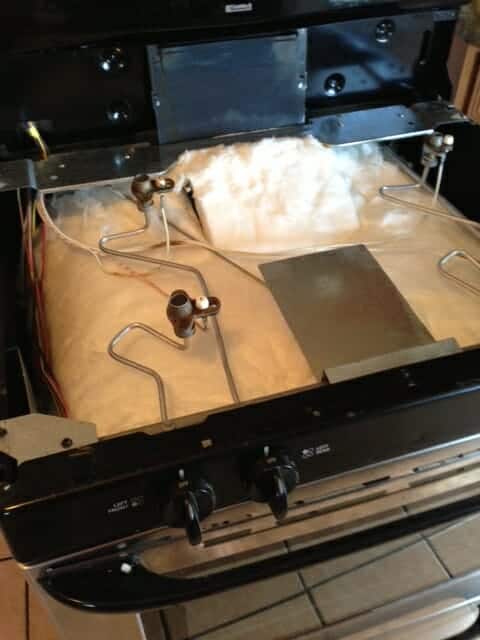
Pretty much like new!
Most importantly, when I ripped out all that old burned insulation, the smell in the house improved dramatically which made Betsy want to stay married to me.
After that, I just hooked up the gas again and plugged everything back together. I had to take off roughly four dozen screws to get the oven apart to clean all the sides and everything.
Then I took a deep breath and lit it up!
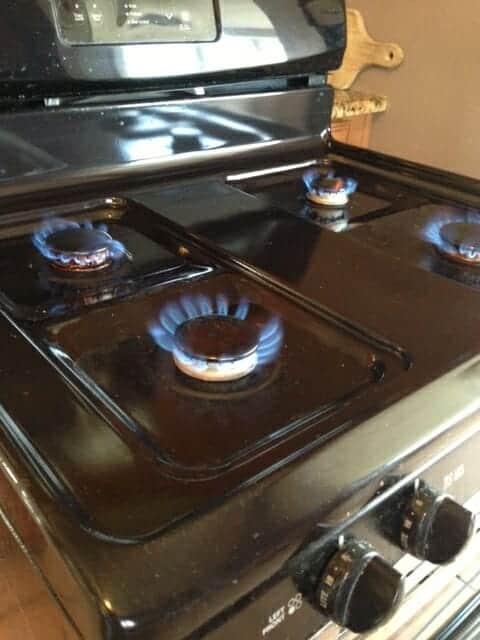
It lit a beautiful blue flame.
I waited. No smoke. No fumes.
I then did the universally recognized Happy Dance.
Tips and Advice
Here is my short list of tips if you ever find yourself in a bind with a stove.
1) Be safe. If you are going to try to take apart or mess with the oven at all, be sure to turn off the gas and electric connections. Explosions suck. It also helps to refer to the owners manual for how to take off the sides and top of the oven.
2) Ask for Help. Don’t be macho if it’s truly new territory for you, but also don’t be afraid to trust your instincts if you think you are getting bad advice. I had this moment where I was staring at the thing and said, “I have a six figure education. I know that burning this off is a horrible idea. I have to be able to figure out how to handle this thing.”
3) Be careful frying. It’s far and away the most dangerous thing you can do in your kitchen. Don’t get rushed with it, even if you’ve done it a million times. Take your time and do it safely.
Through some luck and some sheer stubbornness, I was able to fix this thing and it runs like a champ now. No more smell and no more issues.

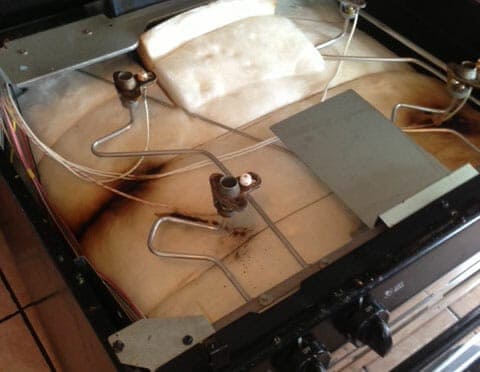
CGCouture
Glad to hear you guys are OK! And I’m so glad you didn’t follow the “slow burn” advice, I can’t believe that they actually told you that!? WTH?!
Have you considered a Fry Daddy? At least a fry daddy doesn’t have any open flames….and it’s a small appliance to have to clean up or replace as opposed to your stove.
Nick
Ha! Yes… some sort of fryer situation will probably be purchased soon. :)
Shanti
We have a small one for the two of us. To prevent oil splatter/bad smells/accidents such as you describe in our place, I have a place for it to plug in outside. Obviously I can’t fry in the rain and parts of the winter, but at least I don’t have to worry about destroying the house.
The cord to ours “plugs” into the actual frying unit with a magnet like the MacBook chargers. It’s great to be able to easily pull the cord and turn the heat off without getting too close to the guy if something looks off. I highly recommend making sure yours has one.
Hank
THANK YOU. Pretty sure you just saved my life. I did the exact same thing. Spilled some oil. Cleaned it up. Took apart the top. Wiped that up. Ignored the insulation. Went to bake something and feel like my lungs are burning from cook asphalt in my oven.
I’m 100% sure my insulation is melted and once my oven cools down, I’m going to find out.
So THANK YOU again for letting me know I’m not the only idiot that’s done this.
Lindsey C.
amazon. yes. I love to filter and sort them if I know nothing about the product I’m buying i get the one with the most reviews that’s high up on the list sorted by customer rating.
Glad you used your head and survived the ordeal without killing the pets. Congrats! You deserve a beer!
Rob
Thank you so much for sharing you experience! I almost had this same problem with cooking wet potatoes and a boil over but caught it in time just a few days ago. I will be drying the potatoes each and every time before I put them in hot oil for a deep fry from now on.
I was thinking that you should add a post on how to clean your kitchen. As any cook I am sure your kitchen gets messy from just regular cooking. I would like to first see a focus on stove tops as I have not found a easy way to clean it. I try to clean it right away but can’t always and now I have baked on mess.
Amy
You are awesome. I’ve always been too afraid to fry anything because I’m sure some sort of catastrophe would happen. Thank you for taking the time to put some additional information out there (you can’t be the only one this has happened to) on the way to go about handling a situation like this. It actually gives me more confidence in the kitchen — not less. That being said, I’ll probably stick to my oven baked fries!
Tadas
Wow, good job, Nick! My stepfather is an engineer and we did this sort of thing when our fridge went on the fritz, but with somewhat mixed success.
Yasmin
I”m glad you managed to stay married…
Julie
Nick you really need to install some cameras (& sprinkler system) in your kitchen, think of $’s you could be making on You Tube. The fire department might buy it for a training video!
Nick
That youtube money is huge. Good call.
Megan
I spilled a whole bottle of vegetable oil on my oven this afternoon and, long story short, we’re buying a new range tomorrow. I can’t get that wakeful smell out of my head and we couldn’t get the stove to stop smoking. Finally, my husband took it outside. Yuck.
Nick
Yikes Megan! That’s the worst. Sorry to hear about it, but glad that you have it out of the house… the smell goes away pretty quickly once you get rid of the offender. :)
Megan
Obviously not wakeful, it was awful.
Steven
Ok I just had this happen to me. A few questions if I may…
1- Looking at my insulation it seems like the oil only penetrated a few layers and I cut it out (Those layers) Do you think it should be fine now?
2-I see there is wire over the insulation, did you replace it after you installed the new insulation?
3-Can I replace the insulation just by opening the top? or do ineed to open the entire oven?
Nick
Oh man… I feel ya.
1) I would suggest replacing the entire insulation. if you wanted to test though, you could rip out the insulation with the oil, close up the oven,and crank it on high. Let it heat for 30 minutes or longer and if it’s warm or hot to the touch then you need to add more insulation.
2) I didn’t replace the wire. The repair guy I consulted with said that the wires were mainly to keep stuff in place during transit. You probably won’t move your oven much so you probably don’t need it as long as you pack it in tightly.
3) You’ll need to take off the sides as well to make sure you get it completely around the oven.
No doubt… it’s at least a day of work, but probably worth the hundreds you’ll save on a new oven.
Good luck sir!
Steven
Thanks for the help and the quick response.
One more thing if I crank up the oven for an hour can I leave the stove top open. Maybe this way i will be able to see where the smoke is coming from exactly
Nick
Hmm… that’s your call. It’s definitely a fire risk (but I did it also). Depends on your comfort level. Definitely don’t leave it unattended and keep a fire extinguisher close buy if you try it. You also shouldn’t be working on it while the gas line is connected which makes that hard…
Experts will say you shouldn’t mess with it and just replace the entire insulation which is probably the correct advice.
Roni White
This just happened to me and my husband (also named Nick) a few weeks ago! He threw a bunch of wet fries into a pot of hot oil, had the huge overflow which he thought he thoroughly cleaned up, and then about a week later I turned on the broiler and noxious smoke started flowing out of the back and sides of the over. Scary stuff! We just built our house about six months ago so all of the appliances are new and since we spent ALL of our money on that, buying an oven seemed out of the realm of possibility … so, like you, we ended up taking it apart. What we discovered under there looked a lot like your first pic so we cut out the blackened areas which was about an inch of layers and then filled the holes with baking soda, then cut the same amount of layers from the inclined area in the back and used that to fill in the spaces. So far, so good but we still haven’t turned on that broiler since …
Nick
Good luck Roni! It’s such a terrible smell… I hope your fix works. :)
Steven
Update: I removed the few layers that were full of oil, cranked up the oven for two hours. The house stank and my wife was ready to kill me . But now its fine, smell is finally out and oven works fine
Cindy Hollingshead
Thanks for the info. Tenants did the same thing to their oven so now I have to clean it up. I’ll let you know how it goes.
Cindy
andre matthew
facing a lot of problems regarding gas leakage in my stove but still can’t founnd the dimage place, how can i find it???? tristaterepairs
Nick
Hey Andre, if you think you have a gas leak you should probably call a professional. That a dangerous situation. Good luck!
Janna
Thank you for posting this, helpful in my repair journey. Daughter tipped a pot of frying oil, and a bunch spilled before being righted, and apparently this stove/oven does NOT have sealed burners. Fun. It was not too extensive of a spill, thank goodness, so I was able to blot the remains in the now burnt /HORRIBLE smell area, trim out the singed part, and back in business. Hooray for the internet!
Mia Boyd
Thanks for the information. I like that the title of your article is “how to break a gas stove”. I definitely don’t need tips on how to do that; I accidentally broke my oven last week. I’m going to need to hire an appliance repairman now, seeing as I have no idea how to fix it myself. Wish me luck!
Nick
Good luck Mia! Hope you are able to get it repaired!
sophia
hi i just moved in to a house and plugged in my gas stove to my gas line and it smells like gas i have to buy a shut off valve so i did it a 3/4 by 5/8 and when i connected it to the gas line to my stove and turned it on it smelled like so much gas i had to turn it off … why is that ?
Nick
Hey Sophia, I would contact a local appliance repairman. Sounds like you might have a larger issue… Good luck!
Trina
You have a gas leak for sure! You need to find the leak by spraying the gas hose with soap bubbles and it will blow bubbles from the leak!
Tracey
Thanks for the article!
I could only find ones about rats as well, lol.
Ours started smoking which pre-heating to make a pizza – I wasn’t completely sure why, but the smell was undeniably unusual! My Dad had made frozen sausages on HIGH earlier in the day and grease had splattered everywhere. I was too nervous to open it up the first day, but now it’s been a few and my confidence has returned – due in large part to your article.
It’s unplugged and the gas has been shut off, so I will open it up and take a look – I have/had a strong suspicion it would be the insulation. I will let you know how it turns out… or you’ll read it about in the news – House blows up in Toronto, lol.
Thanks again for adding levity to an annoying problem. : )
Nick
Ha! I hope it worked out for you Tracey!
Cece
Thanks so much for this post! My husband did the EXACT same thing, we are currently tearing our oven apart at this very moment and sitting outside because our house smells awful
Nick
Yikes. Good luck Cece!
Randall
Nick! Thank you soooo much for your post. I’ve fulfilled all of your directives and only encountered one remaining challenge. The eye that my “wet potatoes” was on, will not light and I certainly don’t want to cause an explosion. All the other four eyes light fine but this one just continues to click without lighting and after a few sections all I smell is gas. Should I help it out with a match flame or what?
Nick
Hey Randall, I’m far from an expert but I think the lighting elements are a different piece that you might need to replace. I know I’ve used a number of stoves over the years that you had to “help along” by lighting with a stick lighter or match when you turned on the stove. Not the safest thing in the world though for sure… I’d be very careful if you try it… You could also probably call a local appliance repair person to come fix the lighter elements for relatively cheap… good luck!
Lataura
I know this is an old post, however, this is new to me! LOL. I literally just did the exact same thing the day before yesterday, except I was making sweet potato fries. The exact same thing happened, the grease boiled over into the burners. The only thing is, is that I didn’t know it had gotten down into the oven and onto the insulation. I cooked the next day, even used my oven to back croissant rolls and nothing happened. It wasn’t until I tried to make dinner that night, turned the oven up to 425, when the putrid smell and “clear” smoke cause my eyes to burn, and my family to yell at me. LOL. Thank you so much for this post. I am not interested in buying a new stove. Now I just gotta get my hubby to feel brave enough to tackle the challenge. I hope this post helps, you have the same stove as we do.
Thanks Again!
Nick
Yikes! Good luck Lataura! I hope you’re able to get it fixed.
Trina
My daughter did this to our stove and we didn’t know until we used the oven and had to clear the house, Lord have mercy and thank you, because I couldn’t afford another because this one’s only a couple years old!!!!
Andy
Literally did the exact same thing yesterday! Glad I found your post! Now to get down to the dirty task
Jeanne
I just bought a brand new range. I was having tile put in my kitchen so I had to use a dolly to move the tange from the kitchen into the living room. When the stove was slightly tilted on its side, I realized I had left a pan full of oil in the oven and the oil was dripping out of the oven from the kitchen to the living room. The bottom of the stove and broiler is covered in oil. I tried to clean it out as best I can, but I’m not sure how much oil is left in the oven. I am afraid to heat up the oven. What should I do
Shannon M Castaneda
I realize this is an old post, but I just had the same issue happen. Looks like the same stove too. How did you get the top open?
Nick
Hey Shannon. Ugh! I’m sorry. It’s the worst. It was many years ago, but I think what I did was pull the stove completely out and there was a series of screws around the sides that secured the top piece on. You have to unscrew all those and it comes off. I hope that helps!
Amy
Okay husband spilled a mixture of olive oil and another sauce and now that burner (countertop built in not attatched to an oven) isn’t working, all others are but it just ticks and wont lite. Is that what yours did or did yours smoke…if it’s not smoking is that maybe. burn off situation they wanted you to try? Any thoughts?!
Nick
Yikes Amy! Sorry that happened. If you can’t pull your burner out and take it apart I’m not sure what you can do really… you might want to call an appliance repair person to take a look… it’s probably not dangerous if it isn’t smoking, but to get it fixed you’ll probably need some expert help!
Cyd
We just had a pot of frying oil overflow on a front burner. While it wasn’t the whole pot, there was enough and that stuff gets around. Description of our range says it has “sealed burners” – does that mean oil probably didn’t make it’s way inside the the stove and we need to clean up just the outside? Thanks in advance for any help. Crossing my fingers.
Nick
Hey Cyd! I THINK you are probably okay but the only way to know for sure is to turn on the stove and run it for a few minutes. If you have oil inside in hot areas, you will know because it’ll start burning and produce a really terrible toxic smell. At that point turn it off immediately and call a repair guy or try to follow what I did! My burners weren’t sealed though so that’s an entirely different situation. Good luck!
Rebekiah
Thank you for posting this. We had something similar just happen. We didn’t know the oil got down into the insulation. I made a pizza the next night and nearing the end of baking my eyes started burning and this horrible smell and what looked like steam started coming from the back of the range right under the knobs. I figured it was just oil that hadn’t burned off but it didn’t stop. Even after unplugging the stove. I have now taken the stove apart and there is LOTS of burnt insulation. Going to start looking into buying new insulation once I’m done cleaning up this oil. The bottom of the insulation at the back is just SOAKED in oil.
Jennifer
I know this is an older article but it’s one of the only ones I have found about dealing with an oil spill on top of a stove. I had half a gallon of oil spill on top of the stove. I do not know how much actually spilled through the stove but I have soaked paper towels every few hours from underneath the stove. Today is day 3 and it’s still leaking oil. I’m having to block the area off because our dogs want to clean up the oil as well. I know I will need to replace the insulation on top and on the left side of the stove. I don’t know if I will be able to find the stove manual online or not I bought it in 2007 from Sears I hope I can find the right insulation as well. Thank you for this article I never knew that stoves had insulation in them until this happened.
Nick
Good luck Jennifer! I still always feel for anybody when I get a comment on this post. It’s a terrible smell, burning insulation. I hope you are able to find the right stuff!
Nervous
Hello,
The same thing to me happened a days ago. Now the smoke alarm goes off every time I cook even though theres no smoke.. I’m scared to open the stove. Who can I call to fix this for me? Can I just call LG?? Help!
Lisa
Same thing happened here. Smoking, terrible. Freaked me out, expected it to burst into flames at any minute! I didn’t think insulation itself was flammable, but the oil saturating it was! I have never in my life had a stove that upon lifting the cook top there were no drip pans between it and the insulation to catch crumbs and drippings. We lifted the cook top and were staring directly at insulation. We didn’t realize we could replace the insulation and bought a new range, without even thinking about whether it is built the same, without drip pans under the cooktop. We are purchasing a deep fryer and will not deep fry on cooktop ever again……….😳